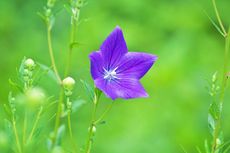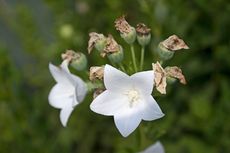Balloon Flowers - Tips For Care Of Platycodon Grandiflorus


Balloon flower (Platycodon grandiflorus) is one of those fun plants to grow in the garden with kids. Balloon flowers get their name from the unopened buds, which swell up prior to opening and resemble little hot-air balloons. Kids are fascinated by these plants and will typically pop them for sport by squeezing the sides, making them burst open with a soft, popping sound. Growing balloon flowers with children can be quite fun. The opened flowers resemble those of bellflowers, their kissing cousin. While most often deep blue or purple, white and pink varieties are also available. Depending where you are, the balloon flower may also be known as Chinese or Japanese bellflower.
Growing Balloon Flowers
The balloon plant is easy to grow and hardy in USDA Zones 3 through 8. It will thrive in sun or partial shade. It likes well-drained, slightly acidic soil; and although the balloon flower plant will tolerate dry conditions, it prefers (and needs) plenty of moisture. This cold hardy plant also prefers cooler conditions in summer, so afternoon shade is a good idea for warmer regions. Seeds can be directly sown in the garden or started indoors in early spring. It is not necessary to cover seeds; simply moisten the area and within a couple weeks you should have sprouts. Thin these to about a foot (31 cm.) apart. Generally, balloon flowers bloom within the same season they are sown.
Caring for a Balloon Plant
Not only are they easy to grow, but these plants are easy to care for as well. If desired, they can be fertilized with a slow-release fertilizer in spring. From there, you simply water as needed. With exception to occasional bouts of slugs or snails, balloon flower pests are few. Basically, all you'll need to do for these plants is sit back and enjoy these long-blooming plants throughout summer. Of course, they may require staking if falling over. You can also add them to cut flower arrangements. Since the succulent stems have milky sap, you'll need to lightly singe the cut ends with a candle (or match) immediately after cutting to make them last longer. In fall you can add an ample layer of mulch for winter protection. Balloon flower plants don't really like being disturbed and although division can be done, it's often difficult. Therefore, propagation by seed is better or cuttings can be taken in spring, if desired.
Gardening tips, videos, info and more delivered right to your inbox!
Sign up for the Gardening Know How newsletter today and receive a free download of our most popular eBook "How to Grow Delicious Tomatoes."

Nikki Tilley has been gardening for nearly three decades. The former Senior Editor and Archivist of Gardening Know How, Nikki has also authored six gardening books.
-
 Urban Composting Guide: How To Compost In The Middle Of The City
Urban Composting Guide: How To Compost In The Middle Of The CityUrban composting does not have to be daunting. You can compost in the city, and maybe even try some urban worm composting!
By Mary Ellen Ellis
-
 Shrub Diseases And Pests To Watch Out For
Shrub Diseases And Pests To Watch Out ForShrub diseases and pests can be challenging. Learn how to recognize and eradicate them before they can present a danger to your plants.
By Susan Albert
-
 Spent Balloon Flower Pruning: Tips For Deadheading A Balloon Flower Plant
Spent Balloon Flower Pruning: Tips For Deadheading A Balloon Flower PlantYou may ask, do balloon flowers need deadheading? The answer is yes, at least if you want to take advantage of the longest bloom period. Learn more about deadheading balloon flower plants in this article so you can enjoy their blooms even longer.
By Becca Badgett
-
 Balloon Flower Propagation: Tips For Seed Growing And Dividing Balloon Flower Plants
Balloon Flower Propagation: Tips For Seed Growing And Dividing Balloon Flower PlantsBalloon flower is such a solid performer in the garden that most gardeners eventually want to propagate the plant to create more of them for their yard. Learn more about balloon flower propagation here.
By Anne Baley